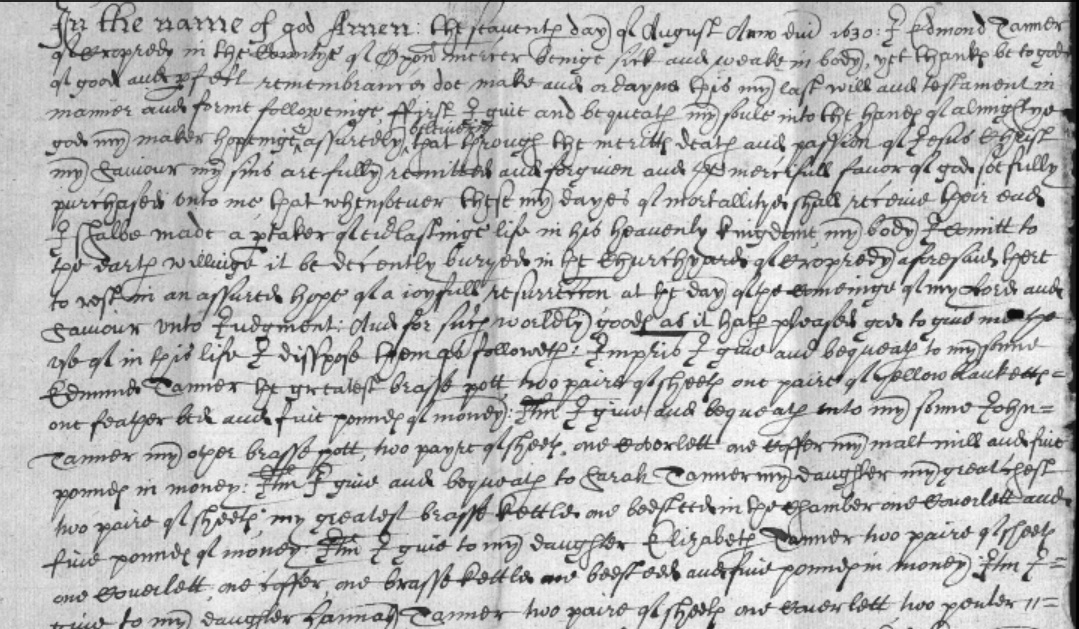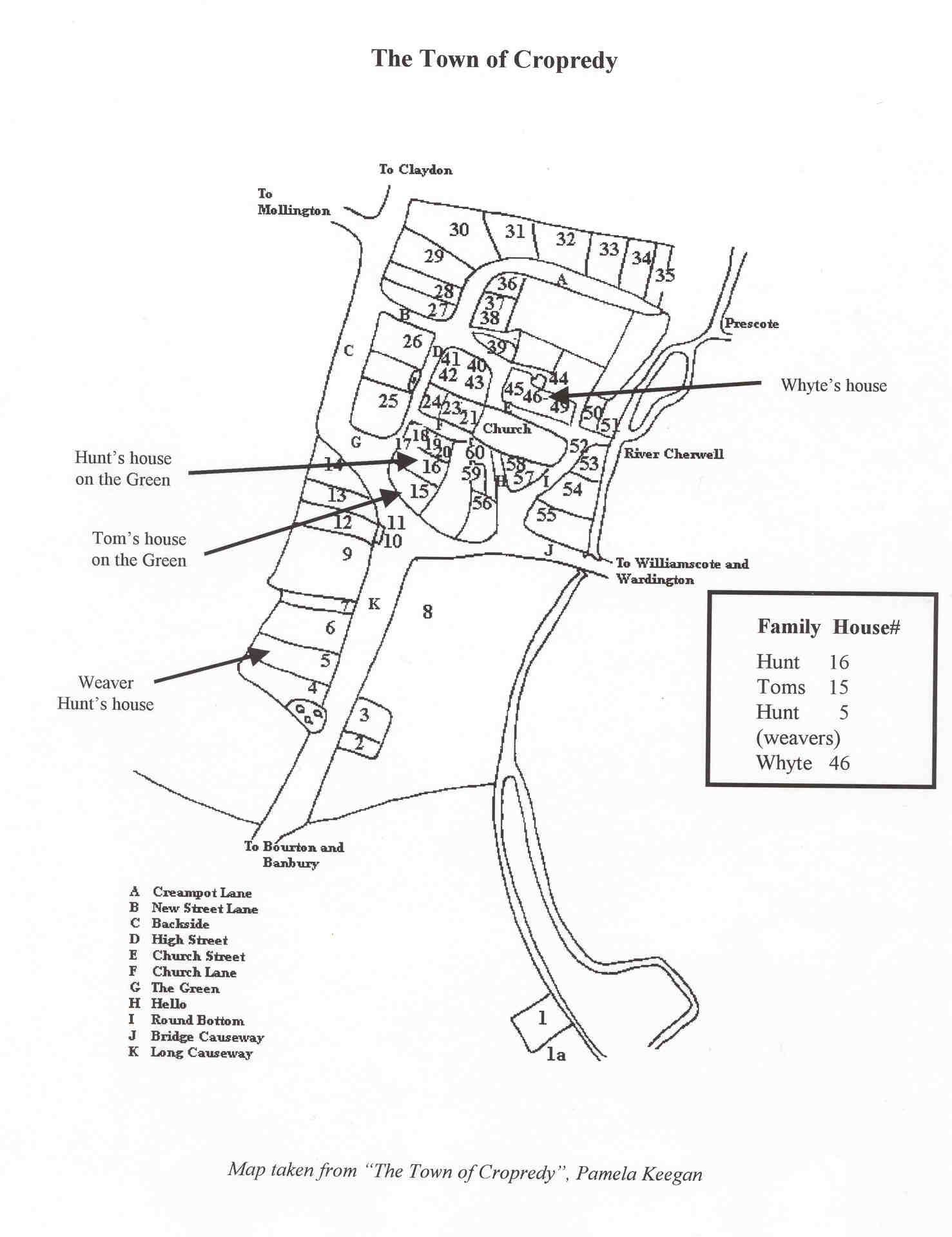Edmond's house is described in The Town of Cropredy: "Due to
the extensive alterations and the loss of part of the western
end it cannot be positively stated that Tanner's was
definitely a long house type, but it was still built as a
smallholding and the business side of the property was taken
from the barn end. If this had three bays then the mercer's
shop was next to the entry and the middle bay made into the
first recorded brewhouse for Cropredy, while the third bay
vanished for an entrance into the yard. The property was built
facing south and had more farm land belonging to it than
Huxeleys or Eldersons. The plot was also taken off the same A
manor demesne close.
Edmund arrived in 1584, the same year Elderson was
married and ten years after the Huxeleys. Did he replace an
earlier shop or was this a new business? Tanners brew house
was a great advantage when the rest of the town were still
using the hall, or the rarer kitchen chimney. Had they decided
to brew for the smaller cottages for they had nine barrels in
the buttery? One of his most important buildings was the kill
[kiln] house where the barley could be malted. It would also
be another means of increasing his revenues by malting barley
for others." (The Town of Cropredy)
Edmond's career is also discussed in The Town of Cropredy:
“It was a different kind of situation when your whole
business ran on credit. Edmond Tanner who had the mercer’s
shop only favoured short term credit. The vicar had to advance
the money against his parish clerk’s next quarterly wage and
also his curate Mr. Man of Mollington, to satisfy the mercer’s
demands. The debts due by the Tanner’s “Shopp booke” in 1630
were slight compared to others “Due from severall persons for
wares as appeth by the shoppbook” £1-8s-4d.” (The Town
of Cropredy 1570-1640)
"How far did the mercer's trade extend to? He bought on
credit, but having to pay this off to purchase more he would
not wish to extend too much to his own customers. This was
confirmed by his lack of trade debts, showing he did indeed
supply very little credit in his shop. He asked the vicar to
pay off Mr Man's (a curate) debts and those incurred by Wam
Reade the parish clerk. The Revd Thomas Holloway wrote:
"Item payde to edmond tanner for the debtes of mr man the vth
of october to b[e] repayd uppo. his wages at saynt Thomas day
xs."
"Item payd to wam Reade for his debts the 3 of october wch he
must repay me at saynt Thomas day next
_____________________vs."
The debts due in Tanners shop book in 1630 were slight
compared to others. "Due from severall persons for wares as
appeth by the shoppe book" £1-8s-4d. Edmund died with £23 of
ready money in his purse which was not a high amount in the
1630's. It was natural for a testator who lay dangerously ill
to call in his bonds to pay off the debts. Margaret King had a
grocers shop, but she was not able to control the credit as
carefully as Tanner had. When she died in 1683 there were
£40-9s8d of desperate debts and £30 of good debts owing. This
was again a period when there was an acute shortage of "good
English money" and the landlord's letters complain bitterly of
arrears.
The first shops often used window boards as counters. Bakers,
butchers and shoemakers opened only on the days they were not
selling their wares at Banbury market. Tanner had a shop door
and an inside counter. Mercers were principally sellers of
silk and textiles, but in Cropredy his customers may have only
brought more serviceable materials. Possibly bolts of material
which Watt's and Hunt's woollen looms could not supply. On his
counter he sold spills, candles, starch, sopetar, pitch and
all other mercery wares. The goods he had in stock were worth
£9.
Many mercers began life as licenced pedlars or roundsmen.
Pedlars needed to be strong young men able to carry a heavy
pack. Many would purchase their stock in London and once an
area had been developed they could afford a packhorse and
perhaps later a second horse. Setting up house in a town and
putting up a stall at the local market showed they were
prospering. They took nonperishable goods out to their
customers - pins, needles and thread being essential to the
housewife. In the pack were trimmings of lace, leather laces,
strong leather points, and various colourful garnishes.
Clothes without buttons required tapes with points and these
were essential items from the labourer to the vicar,
especially when a gross of braid silk buttons were worth seven
shillings at a mercers shop in Banbury belonging to John
Vivers [MS.Will Pec.53/5/6: 1637]. Silk for the gentlemen and
holland, cambrics and lawns for the women to sew. Ribbons for
the girls, gloves, stomachers and girding for the men.
Jewellery in the form of bracelets and brooches. A few if they
were also chapmen would add the cheaper bibles and chapbooks.
The last being too low in value to be found in the
inventories. Had Edmund Tanner started out as a pedlar to earn
his shop? Even though he sold tapes there was still a pedlar
visiting Cropredy, because Thomas Holloway mentions both
Edmund and a pedlar. It is not always clear from whom Thomas
made the purchase. Did the pedlar sell wholesale to Tanner, or
had Tanner to go and collect goods himself? If Tanner no
longer went out to customers did he employ someone like James
Ladd to work as his pedlar?" (The Town of Cropredy)
Edward was an educated man:
"Edward Tanner
had received some education. He was called out to help with at
least three wills, fourteen inventories and asked six times to
be an overseer including once for Suttons and twice for the
Robins. His first wife had no surviving children and she died
after a long marriage of thirty-one years. How had they coped
with this lack of children? Isabell was a Lamprey some of whom
were also mercers...Edmond was in his fifties when he decided
after only three months as a widower to marry Constance Tustin
in November 1615. At last he was able to have children for six
arrive over the next twelve years. Three daughters and two
sons survived, but the Tanners like the Huxeleys and Eldersons
do not remain in the town registers into the next century.
Edmund Tanner left £5 to each of his five children. He had no
freehold land and had apparently not entered any survivors
onto the copyhold. His goods were shared amongst them.
Constance would have the seven years left of the lease. These
legacies were to be paid over to the overseers if his widow
remarried. He expected the two boys to be bound apprentices.
They could inherit at twenty-one, but the girls at eighteen or
marriage. The girls had the eighteen napkins to share and all
five had two pairs of sheets and a coverlet or blanket; the
eldest boy having a pair of yellow blankets. The feather bed
went to Edmond, and the other two beds (mattresses) to two
daughters. Having then run out of mattresses, John had one
coffer and the malt mill and Hannah two pewter platters and a
porringer. This left the greatest brass pot and another pot to
the boys, and the greatest brass kettle and two others to the
girls. "My great chest" must go to the eldest daughter. As
executrix the wife had the rest which included the main
bedstead. John Clarson, clerk, and Edmund’s brother-in-law
John Goodwyn both of Horley, were appointed as overseers. They
had been married for fifteen years and Edmond must have been
around seventy when he died. His youngest girl was buried two
years later. Constance remained a widow for four years and
then married Nehemiah Gardner who was only twenty-nine years
old. Their marriage lasted for two years then Constance died
leaving the children aged eleven, fourteen, sixteen, and
twenty. Nehemiah lived on and married again, a marriage which
lasted for thirty years and produced Samuel in 1645." (The
Town of Cropredy)
Edmond died and was buried 6 September 1630 in Cropredy.
 Burial record for Edmond Tanner in Cropredy: "Edmond Tanner
was buried the vith daye of September"
Burial record for Edmond Tanner in Cropredy: "Edmond Tanner
was buried the vith daye of September"
He left a will dated 7 August 1630:
 Will of Edmond Tanner, 1630
Will of Edmond Tanner, 1630






